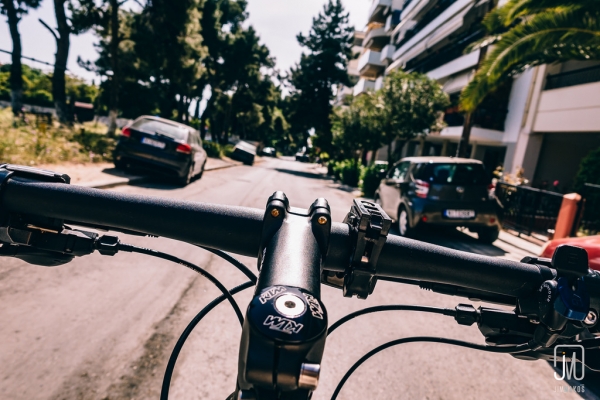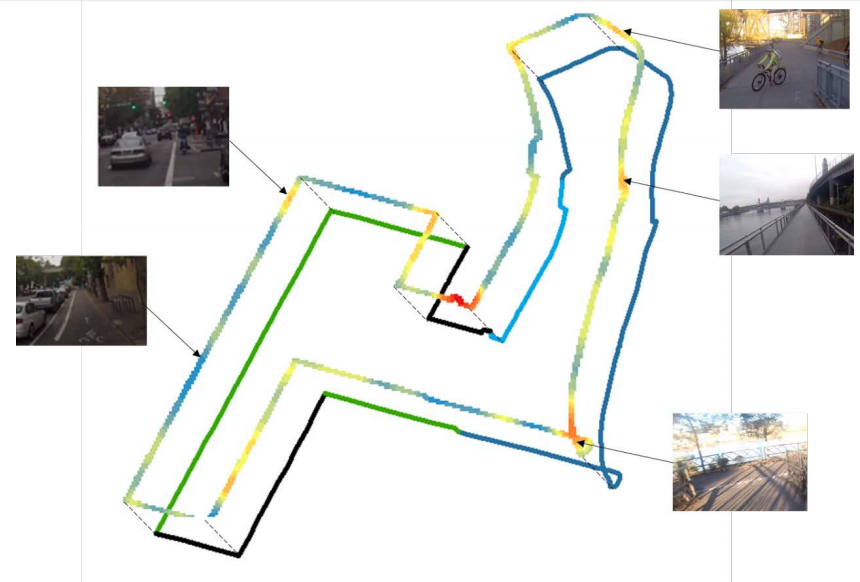Naturalistic study pinpoints route features that cause stress for cyclists

A new NITC report introduces an important tool for safety analysis: a naturalistic method of data collection that can be used to improve the cycling experience.
Before now, most naturalistic studies (studies where data are collected in a natural setting, rather than a controlled setting) in bicycle safety research have been captured by stationary cameras and haven't followed cyclists along a route.
Researchers in this study used first-person video and sensor data to measure cyclists' reactions to specific situations.
Safety research in general has advanced significantly through naturalistic driving studies, which gather data from real drivers to illuminate the causes of traffic incidents both major and minor. For motorized vehicles, the U.S. Department of Transportation has been developing portable, vehicle-based data collection technologies since the early 1990s.
Portland State University researchers Feng Liu, Miguel Figliozzi and Wu-chi Feng sought to capture the cycling experience with physiological sensors and helmet-mounted cameras.
Their report, Utilizing Ego-centric Video to Conduct Naturalistic Bicycling Studies, offers a successful method for integrating video and sensor data to record cyclists’ comfort or stress levels. It also contains detailed observations from five research subjects on four distinct types of bicycle facilities in Portland, Oregon.
The research team fitted a bicycle helmet with four GoPro cameras to provide a 360 view of the cyclist’s surroundings. They used galvanic skin response (GSR) sensors to measure each rider's stress reactions. A smartphone kept track of location using GPS, and after each ride, all the sensor data were synchronized at the research lab.
To help visualize and analyze the data, the research team developed an interactive software system. It can show multiple videos, and the corresponding sensor data, while displaying the cyclist’s geographical position on a map. In the figure on the right, the most stressful moments are the yellow and red points along the route map.
This lets researchers see exactly which route features are most stressful for a cyclist.
They found that close encounters with vehicles, other cyclists, or pedestrians usually accompanied a momentary increase in the rider's stress level. Unexpected obstacles in the bike lane also generated stress.
In general, the most stressful events were situations where a motor vehicle blocked the cyclist’s movement or moved dangerously close to them.
Cyclists and pedestrians are the most vulnerable road users, since collisions with vehicles often result in severe injuries and have high fatality rates. In particular, intersections are one of the most critical areas in a road network given the high number of conflicts and accidents occurring at these locations. In this study, signalized intersections were hotspots for cyclist stress.
The results offer a detailed understanding of cyclists’ perceptions along the route they travel. Rather than having an average measure for the whole route or path, this method lets researchers precisely identify the places and/or situations that trigger a change in experience.
By measuring how different facility types and riding conditions affect the distribution of stress levels among users, transportation engineers and planners may in the future incorporate video and detailed sensor data to evaluate the real-world performance of different types of facilities.
To learn more about this project, visit the project page or download the final report.

